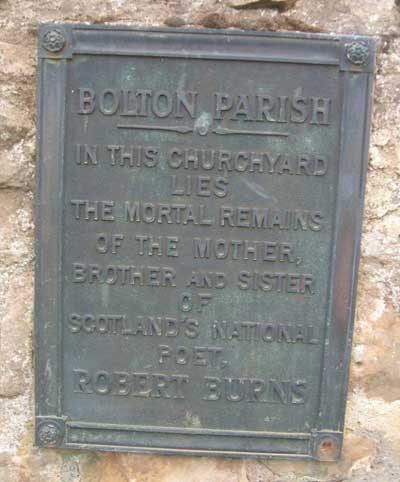Agnes Broun (Brown)
Born 1732. Died 1820.
Research by Kate Neilson
Who is Agnes Broun?
Agnes Broun (or Brown) was born on 17th March 1732 at Craigenton Farm near Kirkoswald in South Ayrshire. She died at Grant‟s Braes in East Lothian on 14th January 1820. Apart from her longevity, unusual because of the short life expectancy at that time, her life was in the main that of a farmer's wife and country woman. However she was a remarkable woman too; her claim to fame is unique as her eldest son was Robert Burns.
 Her father Gilbert was a tenant farmer at Craigenton and her mother died when Agnes was 10. For 2 years she helped look after her 5 siblings until Gilbert remarried and she was sent to Maybole to live with her maternal grandmother, Mrs Rainie (or Rennie), who was renowned locally for her vast repertoire of many old Scots songs and ballads which she passed on to Agnes.
Her father Gilbert was a tenant farmer at Craigenton and her mother died when Agnes was 10. For 2 years she helped look after her 5 siblings until Gilbert remarried and she was sent to Maybole to live with her maternal grandmother, Mrs Rainie (or Rennie), who was renowned locally for her vast repertoire of many old Scots songs and ballads which she passed on to Agnes.
When she was aged 19 Agnes became engaged to Will Nelson, a farm labourer, but broke it off after 7 years because of his unfaithfulness. She later met William Burnes (or Burness) in 1756 at the annual Maybole fair. They were married on 3rd December the following year and their first child Robert was born in January 1759. Although living conditions were hard they raised 7 children and were happily married for 26 years. William was shy and reserved, a hardworking tenant farmer, well respected, with deep religious beliefs and a great respect for learning. Agnes was a charming, lively redhead with a cheerful disposition. She had very little education; she could read a little but was unable to write. However as a farmer's wife she was well skilled in the practical household and farming duties. She was considered to have a fine musical ear and a good singing voice and was said to be always singing. Growing up in such an environment would nurture Robert's love of the old Scottish folk songs and ballads.
As in many families, Robert inherited attributes from both his parents. His father's influence on his upbringing and education was undoubtedly important but his inspiration to be a poet was probably inherited from Agnes with her rich oral tradition and musicality. Another influence on Robert was an elderly distant relative, Betsy Davidson, whom Agnes employed to help with household and farm duties and who in turn, related many dark tales and stories which made a great impression on him. He later wrote that he owed much to an old maid of his mother's whose large collection of tales and songs had, “...cultivated the latent seeds of poesy”.
When her husband died in 1784 Agnes went to live with Robert and Gilbert (her second son) at Mossgiel farm in Mauchline until in 1798, 2 years after Robert's death, she moved with Gilbert and other members of the family to Nithsdale. In 1800 they moved to Morham West Mains in East Lothian. In 1804 Gilbert was employed as a factor to the Lennoxlove estate owned by Lord Blantyre and the Burns family finally settled in a cottage at Grant‟s Braes in the hamlet of Bolton, near Haddington.
With a large family life must have been a struggle but nevertheless they appear to have been welcoming to visitors. Jane Baillie Welsh was a school friend of Agnes's grand-daughters Agnes and Janet and recalled many happy times spent when she visited the Burns's family home and later both Jane and Thomas Carlyle were frequent visitors. Thomas received a letter in 1825 from James Johnston in which he described Agnes as a “... douce, honest, kind, motherly woman” whose warm manner, along with other family members, made him feel part of the family. Agnes remained at the cottage until her death in 1820. She is uried in the churchyard at Bolton Parish Church alongside other family members.
Near Bolton on the roadside from Haddington there is also a monument to Agnes called Burns's Mother's Well where Agnes is said to have drawn water for household needs. The inscription reads:
“Drink of the pure crystals and not only be ye succoured
but also refreshed in the mind.
Agnes Broun, 1732 – 1820.
To the mortal and immortal memory and in noble tribute to her, who not only gave a son to Scotland but to the whole world and whose own doctrines he preached to humanity that we might learn.”
In his last letter to his brother Gilbert, dated 10 July 1796, just shortly before his death Burns ended by writing “Remember me to my mother”.

ERECTED
By Gilbert Burns Factor at Grant's Braes
In Memory of his Children
ISABELLA who died 3rd July 1815
in the 7th year of her age
AGNES who died 11th Sept 1815
in the 15th year of her age
JANET who died 30 th Oct 1816
in the 18th year of her age
And of his Mother
AGNES BROWN who died 14th Jan 1820
in the 88th year of her age.
whose mortal remains lie all buried here.
Also of other two of his Children v/z Jean who
died on the 4th Jan in the 20th year of her
age and John who died 26th Feb 1827
in the 25th year of his age. GILBERT BURNS
thier (sic) Father died on 8th April 1827 in the 67th
year of his age
Also buried here, ANNABELLA
sister of GILBERT BURNS who died March 2nd
1832 aged 67
References:
Haddington Library
- The Haddingtonshire Courier, 30/11/1860 and 6/5/1881
- The Collected Letters of Thomas and Jane Welsh Carlyle: 1824-25, Vol.3 (Duke)
Scotland's People (online and at Register House)
- Old Parish Registers for Ayr, Kirkoswald, and Maybole
Google – www.grantsbraes.org.uk/agnes-broun.html
Books:
Crawford, Robert The Bard: Robert Burns, A Biography,
Jonathan Cape, London, 2009
Daiches, David Robert Burns: The Poet, Saltire Society, Edinburgh, 1950
Green, Charles E. East Lothian, Wm. Green and Sons, 1907
Lang, Theo, ed. The Queen's Scotland; Edinburgh and the Lothians, 1952
Lindsay, Maurice The Burns Encyclopaedia, 1959, 3rd. edition 1980